Regarding “the season is over”
After three months of starting every newsletter with “How was last weekend?”, it should be refreshing to read something different—like random bits of news, views, industry events, travel reports and the like. Starting with folks who say the season is NOT over.
This topic came up last time—I asked if we do a disservice to ourselves, our customers and the end end consumer by thinking in terms of a season that has a start and stop point (the so-called “shoulder seasons” notwithstanding … and maybe a symptom of the issue). A few of you opined:
“Oh, I love this topic! For many years, I’ve asked and hinted and nudged many of the grower/vendors and big marketing folks to really do some education to the consumer about this, too! Some of the best perennials and shrubs don’t even hit availability until June. It’s hard when the customers see all the big box and seasonal annual folks closing up shop, but the season has just begun! Yes, of course, we are all tired after May, but I’d definitely double down for a busy June/July/August, too!”—Candi Scheuermann, Green View Companies, Springfield, Illinois
“We keep buying as needed. It’s easier to reorder gifty things and keep the shop stocked since wholesale websites have improved. Customers still have birthdays, anniversaries, graduations, reunions and events, so they need us to be stocked so they can look good. Houseplants, herbs, pond plants, natives, fruit and citrus trees still will sell well, and then ‘second spring’ kicks in this fall. Season not over here in Sacramento!”—Debbie Woodruff, Fair Oaks Blvd Nursery, Sacramento, California
“Normally, we pot the last of our plugs from cuttings in April. I order Trixi and Mixmasters for containers up into July—not many, as we are small. I used to stop with seed plugs, also in April. Gradually I have added more small shipments. I have added some for mid-May and late May. I also sowed seed for cilantro, dill, cukes and squash. Customers are still coming for tomatoes, cukes, squash, vinca, zinnias, begonias, marigolds and herbs. Last year, we delivered bedding plants and hanging baskets to a garden center on July 1, but this year they stopped buying mid-June. Plants are still selling, but we were down in June due to heat and drought. July is starting out down also. Annuals and perennials are still selling about the same, but trees and shrubs are down. Either the economy or heat has kicked in. Our construction hasn’t helped either.”—Judy Mitchell, Mitchell’s Nursery & Greenhouse, King, North Carolina

A River Ridge Recap
You should have already gotten the Spring 2024 River Ridge Report via my Acres Online Special Edition. You can click the link to read it if you missed it, but to recap:

Gardening in River Ridge was down by 13 homes, to 205 out of 356, or 57.5%. Last year, 218 of my neighbors gardened, or 61%. Look at the historic chart and you’ll see that’s the second-lowest level of gardening in 10 years; indeed, it’s the second-lowest since 2005, when this thing officially launched. That’s bad … but it’s not the biggest single-year decline I’ve seen, which is somewhat heartening. The chart shows a 6-point drop from 2015 and 2016; there was also a 5.5-point drop from 2007 to 2008 (from 68.5% to 63%).
What you said about the River Ridge Report
Here are a few comments that you’ve sent in about the most recent RRR:
From Liz King, Dreaming in Color Design, Boise, Idaho:
“I always love these reports—very insightful! I was musing about why fewer people put plants in the ground or even bother gardening. I think there are definitely many people who don’t like to work outside—many of my neighbors hire lawn mowing, etc. They love to sweat at the gym, but not sweat doing yard work (maybe the perception is that it is unpleasant or ‘beneath’ them to do that kind of work?). I also think perhaps more people might be renters? Housing is very tight in Boise, Idaho, where I live. I think there are more and more renters and they likely don’t have permission to do much with the landscape nor do they want to invest in someone else’s property. I have a neighbor who rents near me that bucks this mindset—she has loads of pots and hanging baskets—a plant luster like me! And houseplants on the inside of her home, too. And I think people fill their lives with other activities like running kids to sports/activities and other adult activities. I’m a little disheartened that many see gardening as such a ‘chore’ instead of something tremendously therapeutic and fulfilling!”
(Editor’s note: I don’t think there are many if any rental properties in River Ridge, Liz. But I could be wrong. Still, nationwide, that has been a trend, and you’re right about renters mostly not being gardeners.
As for gardening being a chore, my dad made weeding one of the most miserable ways to spend a Saturday. I hated it. But he was a depression-era Yankee puritan, whose motto was “Use it up, wear it out, make it do or do without.” A little suffering was good for you.

RRR (continued)
From Sid Raisch of The Garden Center Group:
“All Big 3 KPI’s (revenue, average transaction dollars and number of transactions) are down, down, and down YTD for The Garden Center Group weekly review, as a whole. And the trend is slowed but still going down probably due more to the election trauma, I mean drama.”
(Sid provided these numbers from his members: Revenue -5.2%, Average Transaction -.2%, and Transaction Count -5.2%.)
“There are a few ups in the regions, with Northwest/BC being the only one up in all three of the Big 3 at an average of 2.3% across the Big 3—due to much better weather than they had last year, as I believe you have reported in your weekly weekend reports. A difference here is the weekdays are included in the YTD numbers, and they have been increasing in importance.
“Of the 10 regions, Gulf Coast, South Central and Southeast are suffering the most, followed by Mid-Atlantic and Northeast, to which we could call weather as a primary culprit, but I don’t believe it was weather alone.”
Sid then offered three reasons he is bullish on the long-term outlook (through 2034) of the retail industry he serves:
1. The Echo Boom birth rate of GenY and GenZ was back up even higher than the Boomer birth rate. But we have to get across the lower birth rate of GenX, which is in their highest spending years now.
2. The Sustainability movement is strong within Generations X, Y and Z as they have been educated throughout their compulsory public school years and through college. This includes a very strong interest in providing food and habitat for pollinators, and interest in food security and pro-climate planting and landscaping—which garden centers directly benefit from.
3. The largest generational transfer of wealth in history is underway. Some of that money is being invested in plants and landscaping. Again, these younger generations are aging into their spending years, carrying this major upward interest in sustainability.
Good stuff, Sid! Appreciate your insights, and the data from The Garden Center Group.
Comments or questions for Sid? Share them HERE.

Crickets?
Hortistician Marvin Miller expressed surprise that I didn’t mention the 17-year cicadas in my River Ridge Report. No, I didn’t. A friend mentioned them once, but not living there this spring, I didn’t see or hear them, so they weren’t on my radar. Here’s what Marvin said in a voicemail to me:
“I just read your Spring River Ridge report, and I’m surprised you didn’t mention cicadas. Maybe that didn’t come up. Maybe you didn’t hear them when you were here. They are sort of winding down rapidly. The damage has been done, the eggs have been laid and pieces of tree are dead or dying, at least in my neighborhood. But we have heard a couple of times that came up and led to why people slowed down because they didn’t want to be out there with the bugs, with the cicadas.”
Curious, I asked my friend JP up at Countryside Nursery about 20 minutes north of River Ridge for his thoughts on cicadas. He replied with an apology for not sending me his season-long gut score (8), then said:
“Yes, for sure our nursery department is not having a good year at all because people were not willing to buy a tree with a chance of damage by cicadas. Even though we give a warranty, they still were holding off. We noticed last weekend, with cooler temperatures and cicadas gone, that there is more and more interest in trees and shrubs, so let’s see what this summer and fall brings us.”
However, he add that the cicadas did not affect their greenhouse sales much at all, only nursery. And in River Ridge, I’m counting bedding plants, not trees or shrubs. So I don’t see that cicadas would have affected flower gardening. But hey, maybe Marvin is right about folks not wanting to be out with the bugs.

Ray’s big book of WFT
If anyone could do it, Professor Ray Cloyd could. Write a book just about thrips. And not just any thrips, the Western Flower Thrips. The full title is, “Western Flower Thrips: Insect Pest of Greenhouse Production Systems.” While there have been a thousand journal articles written on the topic, this is the first and only book dedicated to this particular pest. Dr. Cloyd, a long-time and frequent contributor to GrowerTalks, is a professor and extension specialist in horticultural entomology/plant protection in the Department of Entomology at Kansas State University.
Why did he choose Western Flower Thrips? Because for greenhouse producers worldwide, Frankliniella occidentalis has the potential to cause producers substantial economic damage year after year. It’s a major pest that affects a wide range of host crops.

Ray’s book takes a deep dive into biology, damage, management and insecticide resistance of western flower thrips. Each chapter provides a comprehensive review, integrating both practical and applied information. You’ll find in-depth discussions of the latest research in management approaches, including plant protection strategies (such as scouting, sanitation and trapping), as well as insecticide use, resistance development and mitigation strategies and biological control.
Learn more and order your copy HERE.

FW Systems gets new owner
FW Systems is a Dutch internal transport and automation company that you may not have heard of. Unless you’ve read my work over the years, that is, because I’ve followed founder Frank van Dijk’s work after first seeing his amazing equipment at Metrolina Greenhouses in North Carolina in the ’90s. Frank, a co-founder of Dutch internal transport company Hawe, designed and built transplanters, production lines, a shipping belt system, the gantry-style table movers in their MX greenhouses … the list of greenhouse automation is amazing!
Anyway, Frank has sold the business to long-time employee Martin in ’t Veen, who will be joined by his brothers, Aad and Paul Branbander. Martin has been working at FW Systems since 1999, so he knows the customers well and knows exactly what problems can arise and how to solve them. When there are no existing solutions, he makes a custom solution (he’s a skilled welder and mechanic).

Martin in ’t Veen with … hmmm. Are those his brothers? Or some random Dutch welders?

Founder Sonny Costin retiring from CC Racks
It’s been 20 years since Sonny Costin noticed loads of random grower racks behind a big-box store and thought, “That industry needs a pool system.”
Sonny, who had been working for years for CHEP, the blue pallet people, was an expert in the topic of supply chain logistics. Some research, and some communication with the Container Centralen folks in Europe, and Sonny had set up CC here in America to provide the same kind of supply chain logistics for growers that CC Europe had been doing for 50 years.
That was in 2004; today, CC Racks, a division of Container Centralen, based out of Winter Garden, Florida, has some 850,000 shipping racks in their pool, their racks ship to 25,000 retailers in 48 states and Canada, and they do asset tracking, logistics and rack recovery for growers, along with renting racks to meet year-round or seasonal needs.
Anyway, Sonny had decided it’s time to go on to the next big thing (he said he’s got a business idea, but wouldn’t reveal it) as well as spend time back in his home country of Australia, so he’s retiring from his role as president/CEO in September. Taking his place will be current VP of Operations John Paulsen, a 15-year veteran of the company.
Said Sonny in a note about his pending retirement, “We have some exciting projects underway, including use of artificial intelligence to predict rack recovery from retail locations, so that CC and our customers can achieve improved efficiency on this key element of rack operation. There’s so much more to achieve and we have a great team in place to carry the business forward over the coming years.”

A couple things I'm doing during Cultivate’24
That’s where I and much of the industry is headed this weekend, our big national association’s annual trade show and educational conference, sometimes called “Short Course” or just “Ohio” by those of use who’ve been doing it a while. I fly in from Orlando Friday, will help set up the Ball Publishing booth on Saturday, and walk the tradeshow all day Sunday, Monday and Tuesday.
But first, on Saturday afternoon, I’m headed to nearby Delaware, Ohio, to see a new open-roof greenhouse (and all the accoutrements) at Mark Foertmeyer’s place, Foertmeyer & Sons. The greenhouse is a newly designed Rovero Rollair, the first one in North America. I’m especially interested because my old friend Jeff Warschauer, long-time Nexus greenhouse sales and technical guru, is behind bringing these to the states. (There’s also a more standard Rovero HortiHouse wide-span to see.)
Anybody can go—they’ve got two times: Saturday, 2-6 p.m. and Tuesday, 12-4 p.m. Just gotta RSVP HERE.

My panel: Incorporating Sustainable Practices into Your Operation
That’s the title of an education panel session I’ll be moderating, and I think it’s gonna be awesome! That’s because my four guests run the gamut from chemical engineers to hardcore greenhouse experts who are putting sustainable practices to work—and making it pay off with better crops and lower operating costs. Which is the goal, right?
It will be Monday, July 15, from 1:30 p.m. to 2:30 p.m. Eastern.
We’ll start out big picture: How governments, NGO and especially customers are changing the game—the responsibility is shifting UP the chain to YOU, the producer, to account for the resources you consume, the waste you generate and your stewardship of your staff and community. There are regulations on the books in some states now called “extended producer responsibility”. Then we’ll bring it home, with specific ways two well-known greenhouses are improving their crops, lowering energy costs, helping their customers with plastic recycling and much, much more.
As moderator, I promise to hit them with all the hard questions, like “Do I really have to do this sustainability thing? It sounds hard, and expensive.”

What I saw this past week in Chicagoland
While in our old haunts for the River Ridge Report, Laurie and I got out and visited a couple of retailers than never fail to offer a photo-worthy idea or two, Redbud Creek Farm in Sheridan and Blumen Gardens in Sycamore. Both are a long way from the city, so they work hard to be a destination. Check out these finds!
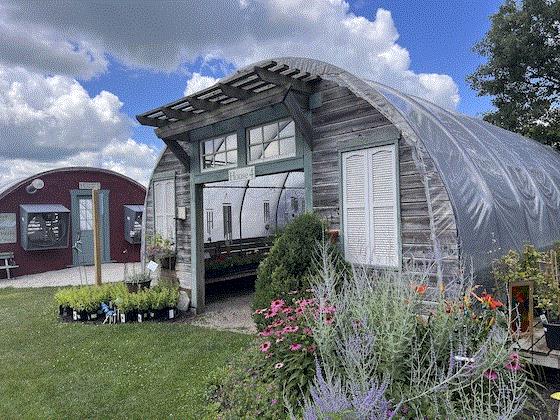
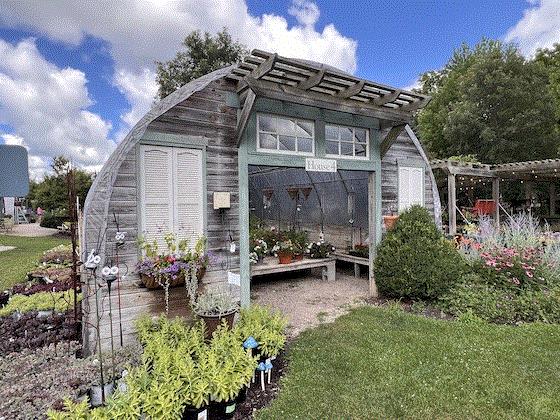 As pretty a façade I’ve ever seen on a hoop house, with the trellis overhead, the transom windows and the shutters. Not to mention the aged barn boards and attractive stained trim.
As pretty a façade I’ve ever seen on a hoop house, with the trellis overhead, the transom windows and the shutters. Not to mention the aged barn boards and attractive stained trim.
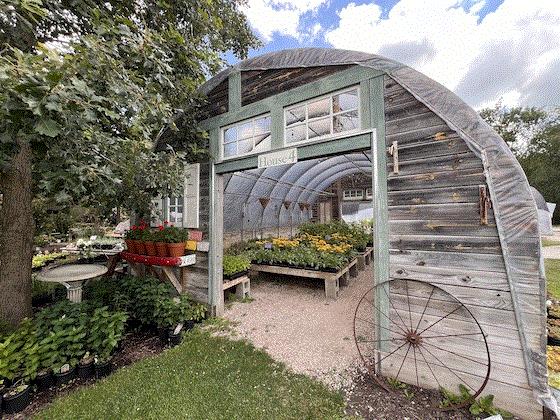
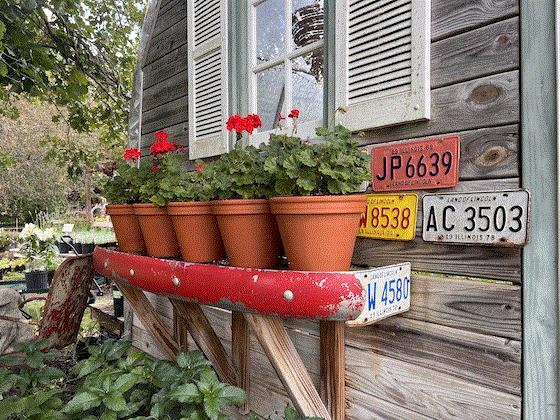 The back of House 4 is equally pretty, and adds the fun of this bumper shelf for pots.
The back of House 4 is equally pretty, and adds the fun of this bumper shelf for pots.
 Checkers, anyone? Yes, the playing pieces are flower pots, some painted black.
Checkers, anyone? Yes, the playing pieces are flower pots, some painted black.
More inspired displays from Blumen Gardens
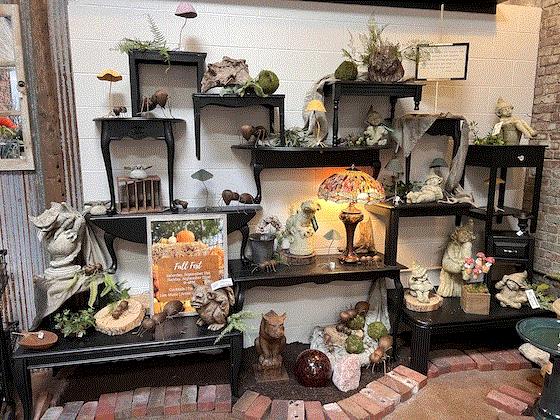
 Blumen Gardens always surprises us with their clever, quirky displays, like these sawn-in-half end tables painted black, stacked and screwed to the wall.
Blumen Gardens always surprises us with their clever, quirky displays, like these sawn-in-half end tables painted black, stacked and screwed to the wall.
 Instead of hanging your old window frames flat on the wall, try some angles, and twinkly lights.
Instead of hanging your old window frames flat on the wall, try some angles, and twinkly lights.
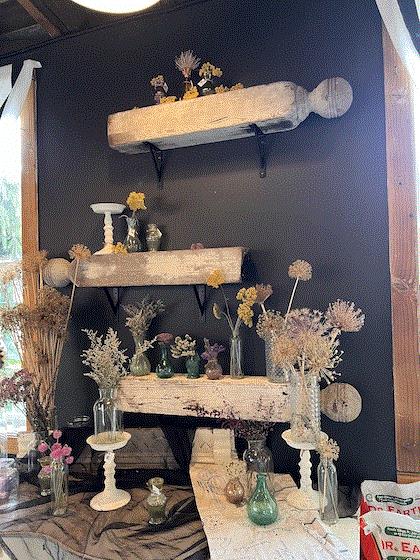 Don’t throw those rotten fence posts away. Turn them into shelves.
Don’t throw those rotten fence posts away. Turn them into shelves.
Finally ...
Joel and his wife, Joan, opened Blumen Gardens 35 years ago, and it’s always a treat to talk to him (and compliment him on the latest displays, which he always credits to his creative staff). We caught up as he was carrying some plants to a customer’s car, and he told me about some of their latest efforts to please customers: They’re doing 65 weddings this year. They’ve got food trucks. Live music. They even have a liquor license.
“I think the fun element is what’s driving us,” he explained, adding, “When you’ve got food, and you’ve got drinks, and you’ve got music, well, that leads to dancing, and that means you’re having fun!”
Then he got serious and said, “Chris, I really want to know this: What is the next thing?” And he looked at me expectantly.
The next thing? I smiled.
“Joel,” I answered, “From the sound of it, you are doing the next thing!”
Feel free to email me at beytes@growertalks.com if you have ideas, comments or questions.
See you next time!

Chris Beytes
Editor-in-Chief
GrowerTalks and Green Profit
This e-mail received by 28,856 loyal readers!
Thanks to my loyal sponsors, who help me reach the 28,856 readers of Acres Online in more than 60 countries. Want to be one of them (a sponsor, that is)? Give Kim Brown a shout and she will tell you about our many advertising opportunities.